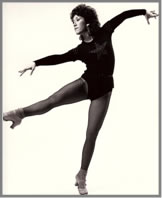Teddy Kern

Interviewed by Lois Silk
What inspired you to become a dancer?
As a ten year old I studied ballet, tap, jazz and modern in Tulsa, Oklahoma. My teachers helped spark my growing interest. By the age of twelve we had moved to Kansas City, Missouri and I had my first professional taste of performing in the corps de ballet at the Starlight Theatre. For a very young girl the enormous size of the theatre and the productions "Meet Me In St Louis," "Carousel," "Oklahoma" and "Brigadoon" were the turning point in my life - I was to be a DANCER!.
Who was the most influential person in your career?
My first choreographer, Harding Dorn. He created these enormous dances to fill this huge stage, The Starlight Theatre, and I was mesmerized by his tremendous power and gentle tenderness as he worked with the dancers. More than being just a dancer, I knew that I, too, would one day create works of art as a choreographer. And so I did!
What was your most memorable dance experience?
My dream, precipitated by Broadway musicals passing through Kansas City, was to be a Broadway choreographer! Little did I know at that time that I would have to pay my dues as a dancer on Broadway before I could take the next step to being a Broadway choreographer. But, as fate would have it, I got my big chance at the age of 29 after being in New York for one year. "Ride the Winds" came into the Bijou Theatre and after a run of two days blew away never to be heard of again and, thankfully, never to be remembered.

Do you have a most frightening moment in your career?
I was dancing in "Brigadoon," which I had also choreographed, at an outdoor amphitheatre in California for the Marin Shakespeare Festival. The kidney shaped stage was surrounded by a water-filled moat. In the opening number I entered upstage on a "hill" and did a series of turns and jete's way downstage to my partner who got distracted - so, I danced right past him off the edge of the stage and landed in the MOAT! There I was SHOCKED - sitting in 2 feet of water. My costume was so heavy by then, I could hardly stand up......but I did, while laughing aloud so everyone would know that I was alright. The audience, orchestra and cast were all stunned. But, being a trouper, I turned to the stage and asked the boys to pull me up, which they did and soaking wet (pure comedy) I proceeded to wring out my costume and exited upstage, squishing all the way. The orchestra resumed playing and the show went on!!
What will your legacy be to the next generation of dancers, and how do you see your experiences with them?
All the thousands of students I've taught and the dancers I've choreographed for and, hopefully, inspired to not just believe in their talent but to appreciate the sublime art and the history of Ballroom and Social Dancing. I have kindled more than a few flames and made some magical dances. My legacy really isn't palpable, it's having touched so many lives. Two years ago, I was inducted into the "Living Legends of Dance" - an organization based in Virginia Beach that recognizes dancers/ choreographers who have influenced the field. I am deeply proud of that.
|
|
Billie Mahoney

Interviewed by Lois Silk
What inspired you to be a dancer?
Mother took me to dancing school at age 4 for good health reasons and I knew that that was what I wanted to be - a dancer! My mother never had the opportunity to be a dancer but she wanted to give me the opportunity. I also did ballet, tap, acrobatic and elocution which led to doing recitations on radio shows and winning first prize in a Baby Parade which was a $5 gold piece at the height of the depression.
Who was the most influential person in your career?
When Luigi came to town, I was in his first class at the June Taylor School. Through notation analysis I was able to understand his unique style and soon was his assistant with a relationship I treasure to this day. I can still remember the day in his class when I found my "center" and discovered how to dance "cool" and "effortlessly."
What was your most memorable moment in your career?
I think the most encouraging words said to me were by José Limon. More than twenty years after being in his classes at Connecticut College, I was teaching Labanotation at the Juilliard School and was asked to assist him in reconstructing some dances of Doris Humphrey with reference to the notation scores. During a rehearsal to the music of Bach's Passacaglia and Fugue in G Minor, for which I had to set the reel to reel tape, I, with my background in jazz and popular music, said to José, "José, I don't know this music." Without hesitation he said, "You will." Such words of encouragement from the person for whom I had such awe - I feel they have guided me to this day in all my undertakings.

What was the most frightening moment you experienced?
In the late 1970’s at the height of my teaching career (Juilliard, Queens College and studio jazz and tap classes), I was stricken with a virus that caused inflammation in all my joints, particularly in any old injuries. I could hardly walk and was hospitalized at Mount Sinai where I saw an ad in the New York Times advertising a Masters in Media Studies. Fearing that my dancing days might be ended, I enrolled in the Degree Program at the New School for Social Research. After a career of being in front of the camera, I wanted to learn what goes on behind the camera. For two years, while my joints were recovering, I studied everything about production, going from camera to person, to audio, to setting up credits, to screening call-ins, to producing.
What will your legacy be to the next generation of dancers, and how do you see your experiences with them?
Talking with my Juilliard students, I decided the world should know who dancers are, what we go through, both personally and professionally, to become dancers. After two years of planning, DANCE ON became a reality, airing twice weekly on early public access television in New York City. More than two hundred fifty shows were done over a 15-year period from various venues around the world with my teachers, colleagues and students as my guests. DANCE ON with Billie Mahoney can be viewed today in the NYC Public Library Jerome Robbins Dance Collection at Lincoln Center.
Billie Mahoney was among the first 5 women to receive the DO40 Legacy Award for her outstanding contribution in dance last December.
|





